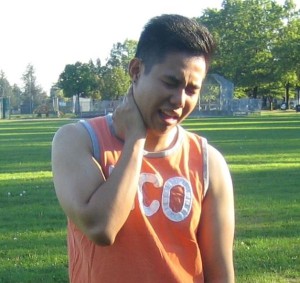Cycling is considered as a sport, mode of transportation or recreation by many individuals all over the globe. When engaging in this activity, it should not trigger any neck pain or sore neck. By implementing minor modifications to the bicycle frame, handlebars, saddle position or even the helmet, any technical issues that might lead to a sore neck can be corrected. In addition, poor posture can also contribute to a sore neck but easily corrected with proper stretching and measured practice.
https://www.youtube.com/watch?v=Tnpw51WAOAA
Observe correct posture
The main causes of a sore neck and upper back pain due to cycling include poor body positioning, poor bike fit and overuse of the muscles in the upper back. Take note that cycling subjects the body in a position in which the back is rounded in a forward manner and the neck is hyperextended with the chin tilted upwards.
This unnatural positioning can cause the neck muscles to shorten and tighten, thus limiting the circulation of blood and resulting to sore muscle spasms. The ideal posture while biking is to ensure that the handlebars are shoulder-width apart and level with the seat. As for the helmet, it should snugly fit so that it will not obscure the vision which can cause further neck hyperextension.
Proper bike sizing

The sizing of the bike to fit the body can make a big difference in the positioning and muscle mechanics. The saddle fore-aft position, saddle height and handlebar position are considered as the 3 critical points of adjustment.
It is important to adjust the height of the saddle so that the leg has a 10-20 degree bend at the knee at the base of the down stroke. As for the fore-aft position of the saddle, it should be adjusted so that when the knee is at 3 o’clock position, the plumb line lowered from the knee base bisects the pedal in the center. The handlebars should be adjusted so that when the individual is seated and the hands are rested on the brake casings, the front wheel hub is concealed from vision by the handlebars while the back is at a 45-degree angle.
Dealing with stiff riding
It is recommended to keep the muscles flexible and slack while the upper back muscles should be relaxed to allow sufficient circulation of blood while riding. The individual should not hyperextend the elbows since this can increase the degree of shock absorbed by the back and neck muscles.
Avoid riding in a “laid out position” with the upper body almost parallel to the ground. Take note that this forces the neck to hyperextend and increase the compression of the nerves, muscles and arteries in the neck and upper back. After a ride, the individual should stretch out. In most cases, it is recommended to perform neck extension and flexion, neck rotation and lateral flexion to help prevent a sore neck.
Easing exercises
Aside from stretching out the muscles of the upper back, it is also vital to engage in reverse shrugs and elbow presses in order to promote proper circulation. For the reverse shrugs, the individual should stand straight and draw the shoulders upwards towards the ears and push backwards and downward behind.
For the elbow presses, point the elbows out to the sides at shoulder level and draw them backwards as far as possible to contract the upper back muscles.
